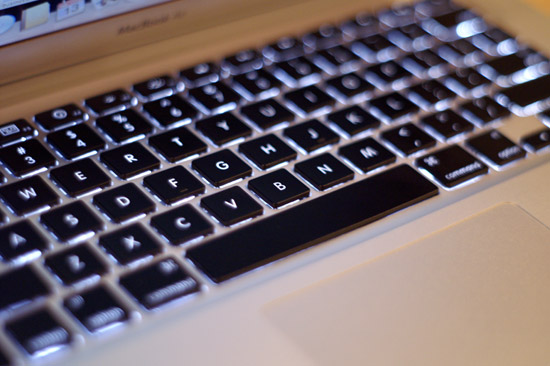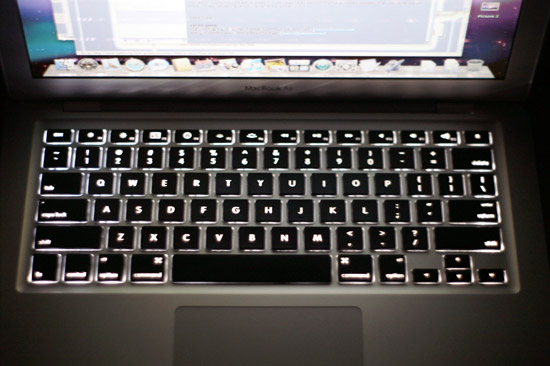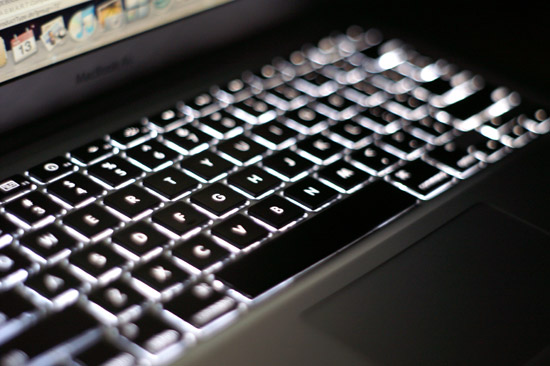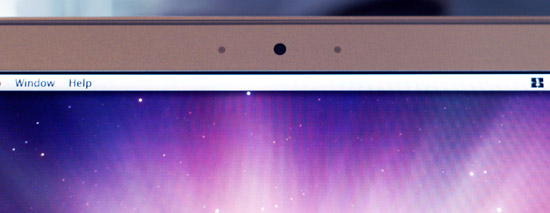The MacBook Air: Thoroughly Reviewed
by Anand Lal Shimpi on February 13, 2008 12:00 AM EST- Posted in
- Mac
The Best Keyboard on an Ultra Portable? Evar?
I can't believe I'm typing this on an ultra portable. I covered CES on an ASUS U1E, which is considerably smaller than the MacBook Air. As pleasant as it was to use and type on, I still found myself running to my MacBook Pro whenever I really wanted to get some writing done. I needed the U1E's portability on the show floor but I needed the MacBook Pro's keyboard when I wanted to get work done. Apple's decision to include a full sized MacBook keyboard on the Air was perfect.

The keyboard is incredible. There's no searching for keys, no fat fingering any two keys and honestly the only complaint I have is that there are no dedicated page up/page down keys.
Typing on this thing is absolutely perfect, the keys have great tactile feedback and make a pronounced but pleasant sound when pressed. It's the same keyboard that's in the MacBook but I've never owned a MacBook, so I'm allowed to fawn on this one a little more than normal.
The edge of the Air's chassis is a little too sharp, which can make typing at some angles uncomfortable. I noticed it when I was using the Air but it wasn't a big enough deal to really bother me.

The fiber optic backlight on the keyboard is an absolute necessity; I'm shocked that more notebook manufacturers haven't adopted it by now. I'm writing this very paragraph in the dark with a well illuminated keyboard and it's great. The backlight alone isn't reason enough to recommend the MacBook Air, but it's a little feature that makes the ownership experience all that much more pleasant.


The keyboard backlight appears to stay on more aggressively than it should, at least compared to the MacBook Pro. The light sensors on the MacBook Pro are located under the speaker grills to the left and right of the keyboard, facing the ceiling. On the MacBook Air, the light sensor is located to the left of the iSight camera on the screen - perpendicular to the ceiling (and presumably the brightest source of light). The end result is the screen dims and keyboard lights up more aggressively than on the MacBook Pro. It's nothing terrible, just an interesting difference. I actually prefer the more aggressive keyboard backlight as a result.

The light sensor on the MacBook Air - to the left of the integrated iSight
There is a problem with the location of the light sensor however; since it's facing you and not facing up, if you are casting a shadow on the sensor it'll make the screen dim. That in itself is fine because you'll also be casting a shadow on the screen, but if you keep moving left and right - casting and removing your shadow from the sensor the LCD will get brighter and dimmer accordingly. If you keep in mind the position of the sensor it's not a problem, but if you don't realize where it is you may end up wondering why the screen keeps changing its brightness while the ambient lighting hasn't changed.

The eject button is kind of cute on the keyboard, when you press it you get the standard eject overlay on the screen - but obviously nothing happens. With the external SuperDrive attached, the button will eject whatever you put in the drive.










41 Comments
View All Comments
sprockkets - Wednesday, February 13, 2008 - link
I don't get it. I can use my Pioneer laptop slot loading burner on an external enclosure and it be powered solely via the one usb port and works just fine, even while writing to dvds.For that matter, I can do the same with notebook laptop drives. Rarely do I need both usb ports connected in order for it to work.
sprockkets - Wednesday, February 13, 2008 - link
Only about 16mbits per second on the xfer rate on wireless? Wow. Were you using n?JarredWalton - Thursday, February 14, 2008 - link
I don't know what Anand used, but I've seen everything from 3MBps to 12MBps on an 802.11n network... all with laptops in the same room, and many using the same chipset (Intel 4965AGN). Overall, N tends to feel about half as fast as 100Mbit Ethernet - or about twice as fast as 802.11G. Router choice unfortunately still has a major influence on 802.11N performance.Imaginer - Wednesday, February 13, 2008 - link
It is what the overall feel and message of the article indicates to me. It is a bit expensive, non-expansive, lacks most utility to be used in most mobile situations, and it is purely for computing on the bare minimum.Kind of like that so called weekend car. I don't think I myself will have ANY need for such a device. Give me a powerful desktop and a versitle yet remaining non cumbersome notebook anyday.
Most people in the market for a laptop usually would use it like their normal away from home computer and because of this, the air really disappoints. (not that I would invest in a new computer anytime soon).
jedmitchell - Wednesday, February 13, 2008 - link
hey, so good review overall -- kept it very even handed considering the difficulty of reviewing a niche product like this. one hardware point I'd like to mention though is the info you give on the X3100. certainly the idea behind it is that as an integrated controller it won't provide very fast graphics, but there's a trick here: most of the things it's not rated to run... run. at least on the older macBook (santa rosa). final cut pro, maya, and photoshop actually all run pretty seamlessly on the X3100, both in OSX and windows (fcp is more memory/drive limited there than GPU). the only small problems are in windows where the X3100 drivers by intel are actually lacking several openGL 2.0 features present in apple's version.the X3100 even plays older games on windows without much trouble -- I can run the Orange Box games at 1024x768 with high quality settings and see a fairly regular 30fps, less a few texture memory glitches. anyway, it would be interesting to see how that performance in the same chipset scales from the macBook to the air.
jdwango - Wednesday, February 13, 2008 - link
However I wish you had also tried to install Windows XP/Vista via boot camp and reported your thoughts.joey2264 - Wednesday, February 13, 2008 - link
This would be a fairly good review if you would just mention the fact that most of the sacrifices Apple made to create the Macbook Air simply weren't necessary. If you look like at a notebook like the Fujitsu Lifebook S6510 of the Lenovo X300 this becomes clear. Looking at these two notebooks, it is obvious that each of the manufacturers could have come up with a 13.3 in, 1 spindle notebook that didn't make hardly any other compromises (decent keyboard, decent port selection, replaceable battery, upgradeable memory, standard 2.5" hard drives (Lenovo could have probably fit a 2.5" hard drive in there if they had used a 13.3" screen, with the requisite larger footprint, although it would have been a little heavier), etc).michael2k - Wednesday, February 13, 2008 - link
The S6510 you mention is heavier (by a pound) and nearly twice as thick! It is much more comparable to a MacBook (5 pounds and an inch thick vs 4 pounds and 1.42 inches thick).The X300 is also not available yet, so a comparison will have to wait until we find out about price and build quality.
mlambert890 - Thursday, February 14, 2008 - link
OK, so then the Sony TX, the Fujitsu P7k, the Toshiba Portege, the Dialogue Flybook, the Panasonic Toughbook, the Dell XPS1210, the Sony SZ, The LG XNote....There's a pretty long list of notes that are smaller and ligher or as light or slightly heavier with a lot more features than the MBA.
The MBA is THINNER. Last I checked thinner is a BS feature. When someone can explain to me WHY thinner means ANYTHING beyond looking cool at Starbucks, maybe Ill be interested.
The Sony X505 was pretty much the same situation as the MBA except it had a removable battery and more ports and that was 3 years ago. I think the MBA was like .2" thinner than the Sony *at its thinnest point* and about the same at the thickest.
The MBA is big news for the cult of Mac which lately is including PC sites like this.
michael2k - Friday, February 15, 2008 - link
Fujitsu P7230: Too slow (one core at 1.2GHz vs two cores at 1.6GHz), half as much ram (1GB vs 2GB) for the same priceDell XPS 1330: You can't get a 1210 from Dell.com (one pound (33%)heavier) for 2/3 the price
Sony TZ250N: You can't get a TX from Sonystyle.com, too slow (2 cores at 1.2GHz vs 1.6Ghz), too expensive ($600 more)
Sony SZ750N: Too big and heavy (1 pound (33%) heavier and twice as thick) for the same price
You argue against thinner: Thinner is only a measure of weight. Compare to 3 pounds (2.7 to 3.2 pound) and you already eliminate the toughbook, the Dells, the Portege, and the SZ. Compare to the CPU speed and you eliminate the Fujitsu and Sony TZ.
So what is left? The Lenovo X300, which is still more expensive, but for that extra expense you get an optical drive.